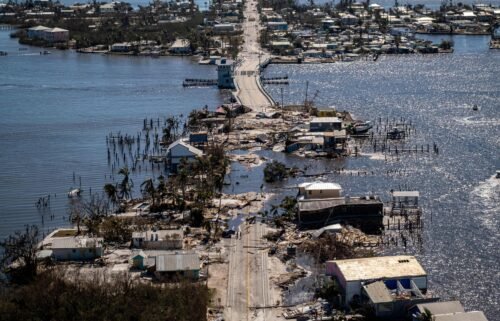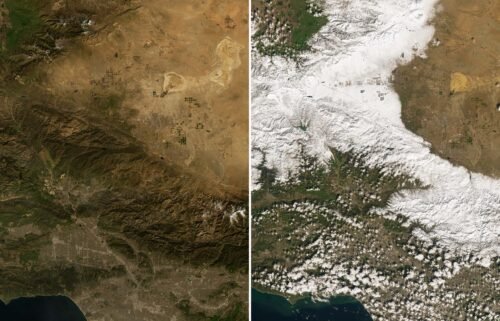First Atlantic hurricane season forecast issued on the same day as El Niño watch

Colorado State University is predicting 13 named storms
By Allison Chinchar, CNN Meteorologist
The Atlantic hurricane season doesn’t officially begin for another seven weeks, but early signs indicate there is more uncertainty than normal with this particular season — all thanks to El Niño.
Colorado State University released its 2023 Atlantic hurricane season forecast on Thursday morning and is predicting 13 named storms, six hurricanes and two major hurricanes (Category 3 or higher). Each of these numbers is slightly below the typical season average of 14 named storms, seven hurricanes, and three major hurricanes.
“We anticipate that the 2023 Atlantic basin hurricane season will have slightly below-average activity,” said Phil Klotzbach, a research scientist in the Department of Atmospheric Science at CSU.
“Current neutral ENSO (El Niño Southern Oscillation) conditions look fairly likely to transition to El Niño this summer/fall. However, there is considerable uncertainty as to how strong an El Niño would be, if it does develop.”
Klotzbach says that one of those factors leading to uncertainty is sea surface temperatures in the eastern and central Atlantic. Sea surface temperatures are one of the ingredients needed to fuel hurricanes. The warmer the ocean, the more fuel available for the storms to tap into. And currently, sea surface temperatures are much warmer than normal, which means, even if El Niño does develop, the potential still exists for a busy Atlantic hurricane season.
While CSU’s forecast calls for slightly below-average numbers overall, the odds of a US landfall appear to be as high as in any normal year.
“We anticipate a near-average probability for major hurricanes making landfall along the continental United States coastline and in the Caribbean,” Klotzbach said.
“As is the case with all hurricane seasons, coastal residents are reminded that it only takes one hurricane making landfall to make it an active season for them. They should prepare the same for every season, regardless of how much activity is predicted.”
The biggest factor this year will definitely be El Niño.
“How quickly El Niño sets in could have significant impacts on how hurricane season unfolds, as it is one of the primary weather patterns affecting tropical seasons in the Atlantic and Pacific,” said CNN Meteorologist Brandon Miller.
“You can’t accurately predict this hurricane season without accurately predicting when and how intense El Niño will get by this fall.”
It all comes down to El Niño
El Niño traditionally inhibits hurricane activity, whereas La Niña or ENSO neutral conditions create a more favorable environment for tropical storm development.
The Climate Prediction Center issued an El Niño Watch on Thursday morning, indicating there is a 62% chance of El Niño developing during May-July 2023.
The exact timing of El Nino formation will be key, as well as how robust this particular El Niño becomes.
“El Niño tends to have its strongest impacts on hurricanes forming in the deep tropics,” Klotzbach said. “So, Caribbean storms tend to really get knocked down in El Niño years, due to increases in vertical wind shear.”
But systems that form in different areas of the Atlantic (tropical regions versus higher latitudes) are affected differently by El Niño.
“That is why we tend to find a strong reduction of hurricanes making landfall in Florida and along the East Coast in El Niño years, especially when the El Niño is fairly strong.”
But this isn’t the case for all areas of the US coastline. Klotzbach cautions that the reduction of storm activity along the Gulf Coast is actually weaker.
“While Gulf landfalling hurricanes can come from either tropical Atlantic or Caribbean storms, these systems can also form in … the Gulf of Mexico from entities like cold fronts. These systems don’t appear to have much modulation by El Niño/La Niña.”
Even if the season does end up below average, at the end of the day, it only takes one landfalling storm to be impactful.
“I think it’s important to convey that seasonal forecasts in April always have lots of uncertainty, but this one has even more uncertainty than normal given the potential combination of a robust El Niño but also a very warm tropical Atlantic,” said Klotzbach.
In fact, Klotzbach points out that some weather forecast models are predicting the warmest August-September values on record for both the tropical eastern and central Pacific and tropical/subtropical Atlantic basins.
“Typically we say that a strong El Niño trumps a warm Atlantic, but it’s unclear exactly how strong El Niño would be and how warm the tropical Atlantic is going to be.”
The-CNN-Wire
™ & © 2023 Cable News Network, Inc., a Warner Bros. Discovery Company. All rights reserved.


